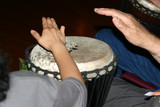Handpan Drums: Resonance Unleashed
Handpan or Hang drums are pretty great. They’re new, funky, and the more that people get into them, the more varieties are developed. The original PANArt Hang Drum was just the beginning, and it wasn’t even that long ago that it busted onto the drumming (hand percussion, idiophone, music) scene. In 15 years, the delightfully odd and harmonic sound of handpan drums has captivated more than just street performers and drum circle attendees. These crazy percussion instruments are finding their way into recordings and stage performances, and into our hearts.
So, how do you actually PLAY a handpan drum, a round-shaped, metal object that has dimples or cuts in the surface? There’s an inherent knowledge of how to play most other drums, you just strike the drum head with your hand, a drum stick or other implement in order to make it go “boom.” Handpans don’t look quite so intuitive to play; they look pretty complicated. But if you ask anyone who has played a handpan, “intuitive” is one of the best words used when describing how to play it.
Playing the handpan does require some patience. Keep in mind that some handpan drums are made from alloys that are very malleable, which is how the “hand-hammering” and tuning work to make them resonate in such an “otherworldly” way. That’s also how they can get damaged – a person who plays a little too hard can change the surface of the more delicate handpans, or can bend the “tongues” of the cut-out varieties. The techniques below should not be attempted until you fully understand that you are a powerful person who has every ability to break your new handpan, so be gentle.
Handpan techniques include standard hand drumming “hits” that use your entire hand (if you want). You can lightly tap with your fingers, get a medium tone with your thumb, or a deeply resonant sound with the heel of your hand. Once you master these, then you can move onto more advanced techniques like the hand roll (rotating your thumb and the outer edge of your hand) for fast playing, or experimenting with dragging your finger or palm across the surface of the handpan. Some handpan players even “bend” the tone of the drum by pushing in on the surface. Your results will vary, but, you should definitely try them all out.
Some people also play their handpan drums with mallets. Just be careful about damaging your instrument, or throwing off its resonant groove by using mallets or anything other than your hand.
Now that we’ve said how to hit it, there’s that lingering question of where to hit a handpan drum. There are dimples and notches and tongues and grooves. It can look like a map to a long stream of wrong notes for anyone who hasn’t played the instrument, but once you realize just how easy it is to sound like a handpan pro, you’ll be ashamed for even hesitating.
Handpan drums are all tuned idiophones, so there is a harmonic value to each and every inch of the instrument. You’ll need to research your specific handpan’s sound map and its scale, but, know that the entire surface works together to create a tonal experience like none other. You need to have an ear for music (and rhythm!) to make the most of the handpan, of course. Part of the beauty of these instruments are how they make you sound good, even if you have no idea what you’re doing. Playing the handpan is more of an experiment in your creative musicality than a list of instructions or some sheet music could ever be.
When you’re ready to make the handpan plunge, be sure to do your research. They’re all different, wonderful and worth the effort in finding yours. Although, it has been said that you don’t choose your handpan, it chooses you… and what better instrument to add to your collection than one that nobody really knows how to describe, just like you!
Recent Posts
-
X8 Drums Play-Along Backing Tracks
The new X8 Play-Along Series is being produced for our musician friends wanting a fresh way to work …9th Feb 2025 -
What is the Best Size Djembe for Beginners?
If you're new to the world of percussion and interested in learning the djembe, you're in for a t …16th Jul 2024 -
The Benefits of Becoming a Drumming Teacher: Transforming Passion into Profession
Why become a drumming teacher? Becoming a drumming teacher is an excellent way to share your pas …22nd May 2024



